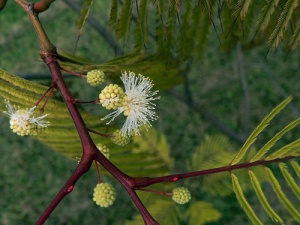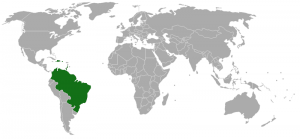Anadenanthera peregrina
| Note: | This page is a work in progress -- its content throughout is not yet complete. |
| Anadenanthera peregrina |
|
|---|---|
| Tryptamines known to be present in A. peregrina [1] Bufotenine (seeds)Bufotenine N-oxide (seeds)N,N-Dimethyltryptamine N-oxide (seeds)N,N-Dimethyltryptamine (bark)(pods)(seeds)5-Methoxy-N-methyltryptamine (bark)O-Methylbufotenine (bark) (seeds)N-Methyltryptamine (bark) |
Endemic to the tropical savannahs and semi-deciduous forests of South America and some Caribbean islands, Anadenanthera peregrina (common names include yopo, cohoba, mopo, nopo, parica ) has been utilized as a botanical medicine and entheogen by peoples living within its range for thousands of years. It is known primarily for the various psychoactive phytochemicals present throughout the plant, most notably for its many biologically active tryptamines. A. peregrina also benefits the quality of the soil where it grows by increasing levels of soil nitrogen through the nitrogen-fixing rhizobia contained in its root nodules. Belonging to the third largest family of flowering plants, Fabaceae (formally Leguminosae) this leguminous tree is one of only two known members of the genus Anadenanthera.
Contents
Introduction
Utilized by indigenous peoples as a medicine and hallucinogen for thousands of years, Anadenanthera peregrina was first described as a species in 1737 in the Hortus Cliffortianus from a specimen in Holland,[2] though the use of the hallucinogenic snuff (usually called yopo or cohoba) produced from the seeds and other parts of this species were documented by Spanish explorers as early as 1496.[3] Linnaeus included the species in his Species Plantarum under the name Mimosa peregrina.[4] The botanical identity of yopo was not known to the West until June 1854, when the ingredients and preparation of yopo were observed by British botanist Richard Spruce.[5][6] Spruce later published Notes of a Botanist, a record of his explorations throughout South America, in which he includes descriptions of the plants and processes utilized by the indigenous peoples to produce hallucinogenic snuffs from A. peregrina and other plants.[5]
Description
This species is one of only two generally recognized members of the genus Anadenanthera, with former divisions primarily concerning four subspecies or ecotypes. After placement in several different genera, most taxonomists accept the rigorous work of Sirri von Reis Altschul, who in 1964 revised the taxonomy of the genus to include only two members, A. colubrina and A. peregrina. Of the latter (and the focus of this paper), two variants are recognized: A. peregrina var. falcata, and A. peregrina var. peregrina. For the purposes of this paper, Altschul’s description is provided:
Anadenanthera peregrina (L.) Speg.[7]
Shrub to tall tree, 3-27 m high. Trunk 20-40 cm in diameter at breast height, usually leaning, twisted, sometimes divided at the base into several shafts; more frequently the contorted, irregular branches spread out above the middle of a solitary trunk into an umbrella-like crown. Bark gray to nearly black with many small lenticels; unarmed or lower trunk producing conical thorns of wedge-shaped projections, sometimes intensely so when young, becoming tubercular-verrucose, corky, rugose and, in drier climates, very thick. Young twigs and foliage puberulent, occasionally glaucescent; mature foliage glabrous or nearly so. Leaves, including petioles, 12-30 cm long, the main rachis more or less channeled ventrally. Petioles somewhat darkened at their bases, 5-15 mm above which bears a flattish, oval or oblong gland .5-5 mm long; 1-4 similar, smaller glands borne one between or just below each of the ultimate pinna pairs. Pinna pairs 10-30 or more, each pinna 2-5 cm long, opposite or subopposite leaflets usually imbricate 25-80 pairs, 2-8 mm long, .5-1.5 mm wide, linear, oblong or lanceolate, straight to falcate, at the base oblique or truncate, at the apex acute to acuminate to apiculate; excentric mid-vein; membranous to coriaceous and nitid, sometimes differing in color and texture dorsiventrally. Heads 10-18 mm in diameter, including stamens, greenish white to creamy yellow, in fascicles of 1-5, puberulous to glabrous in the bud; the heads axillary to the leaves and subterminal, rarely becoming arranged in racemous patterns in the branch apices. Peduncles 1.75-4 cm long, puberulous, filiform or thicker, each bearing about three-quarters of the way up the axis a puberulous bi-dentate, campanulate involucre which becomes detached and slides down to encircle loosely the base of the peduncle. Calyx .5-2.6 mm long. Corolla 2-3.5 mm long stamens 5-8 mm long; anthers eglandular in the bud. Legume 5-35 cm long (including the stripe but not the peduncle), 1-3 cm wide, straight to falcate, oblongish to elongated, regularly to irregularly, vaguely or not at all contracted around the seeds, more or less flattened with margins slightly thickened; at the base attenuate to obtuse, at the apex mucronate to acuminate to cuspidate or, if the tip has broken off, rounded; surface scurfy to verrucose, and dull; dark brown with rufous scales in dried specimens. Seeds 8-16, very thin, flat, orbicular to suborbicular, dark chestnut brown to black, shiny, 10-20 mm in diameter.
Relation between the phytotomy of A. peregrina and its ecology
Like many members of Fabaceae, A. peregrina develops root nodules which allow the plant to develop symbiotic relationships with host-specific soil bacteria, thus creating a bioavailable nitrogen source in nutrient-poor soils allowing the plant sufficient nitrogen to synthesize amino acids. This ensured supply of nitrogen may contribute to the ability to synthesize various tryptamines, as many members of the subfamily Mimosoideae do.
A. peregrina also demonstrates unique reproductive characteristics that are likely an adaptation to its environment. Its breeding system has been demonstrated to be preferably xenogamic, a strategy shared by many plants which ensures genetic diversity thus greater survivability. However when forced to produce fruit via autogamy, A. peregrina gradually increases its own genetic self-compatibility, a strategy which favors the progeny presence in a fragmented forest environment.[8]
Habitat and range
A. peregrina is endemic to the tropical savannahs and semi-deciduous forests of South America and some Caribbean islands.[1] In the Cerrado Biome of South America, it is one of the more common species of trees found in low altitude tropical seasonal forests, occurring in greater than 50% of surveyed locations in Brazil’s Sao Paulo state, and in more than 70% of surveyed locations among the seasonally dry tropical forests of the central-west region of the Biome.[9] Because of the nitrogen-fixing rhizobia found in the nodules of its roots, A. peregrina is able to thrive in the often nutrient-deficient soils of the cerrado.[10]
Phytochemicals with an emphasis on psychoactive compounds
Tryptamines known to be present in A. peregrina
- Bufotenine (seeds)
- Bufotenine N-oxide (seeds)
- N,N-Dimethyltryptamine N-oxide (seeds)
- N,N-Dimethyltryptamine (bark)(pods)(seeds)
- 5-Methoxy-N-methyltryptamine (bark)
- O-Methylbufotenine (bark) (seeds)
- N-Methyltryptamine (bark)
- N,N-Dimethyltryptamine (roots)
- Bufotenine (roots)
- 5-MeO-DMT (roots)
Flavonoids known to be present in A. peregrina
- Isoorientin (leaves)
- Isovitexin (leaves)
- Leucopelargogidin (bark) (pods)
- Orientin (leaves)
- Vitexin (leaves)
Human use
Conclusion
See also
Sources
Fraser, Lauchlan H. Paul A. Keddy. 2005. The World’s Largest Wetlands: Ecology and Conservation. Cambridge University Press. p. 228.
Fellows & Bell 1971; Schultes et al. 1977b; Torres & Repke 1996
- ↑ 1.0 1.1 Southon et al. 1994. Phytochemical Dictionary of the Leguminosae. CRC Press. p. 71.
- ↑ Torres and Repke. 2006. Anadenanthera. Haworth Press.
- ↑ Schultes, Richard, Siri Von Reis. 1995. Ethnobotany: Evolution of a Discipline. Timber Press.
- ↑ Safford, W.E. 1916. Identity of cohoba, the narcotic snuff of ancient Haiti. J Wash Acad Sci. 6:548-562.
- ↑ 5.0 5.1 Spruce, Robert. 1908. Notes of a Botanist. pp. 427-432.
- ↑ Davis, Wade. 1996. One River. Simon & Shuster. p. 476.
- ↑ Altschul, S. von Reis. 1964. A taxonomic study of the genus Anadenanthera. Contributions from the Gray Herbarium of Harvard University 193: 1-65.
- ↑ Costa et al. April 2003. Reproductive system of Anadenanthera peregrina and Vochysia haenkiana in a fragment of “Cerrado forest” from Chapada dos Guimaraes – MT, Brazil. Ciencia Rural vol. 33 no. 2. Santa Maria.
- ↑ Pennington et al. 2006. Neotropical Savannas and Seasonally Dry Forests: Plant Diversity, Biogeography, and Conservation. CRC Press. pp. 50, 61, 70, 190.
- ↑ Reatto et al. 1998. Solos do bioma Cerrado. In Cerrado: ambiente e flora (S.M. Sano and S. P. Almeida, eds.). Embrapa-CPAC, Planaltina, p. 4786.


